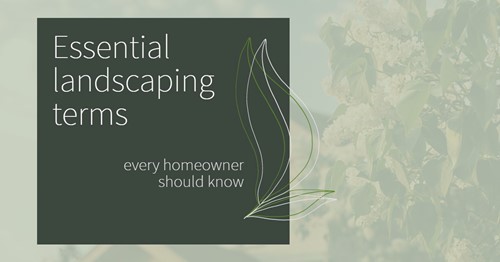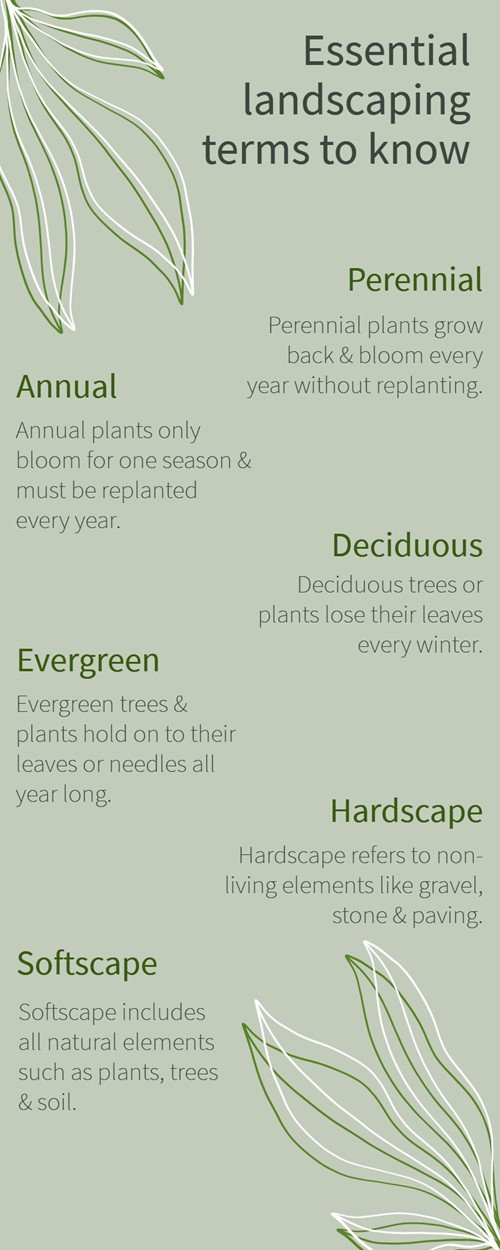
If you’re just getting started with landscaping, it can seem as if it has a language all its own. While landscape designers use specialized terminology to describe the ins and outs of their work, most of the important language overlaps with gardening, architecture and real estate. This means you might already know more about landscaping styles and features than you think!
Regardless of your experience level or goals, knowing the right terms can help you understand the key elements of landscaping. To help, here is a guide to some of the most important terms to know:
Perennial is a term used to describe plants that only need to be planted once to grow and bloom every year. Perennial plants and flowers can last multiple years and even decades with the right conditions and care. Well-established perennials are low maintenance landscape features that can increase your property value, whether located in your front yard or backyard.
As a contrast to perennial plants, annual plants only last one season. This type of plant includes many of the most popular flowering shrubs for increasing curb appeal in outdoor spaces. Annuals make a great landscaping choice for homeowners who like to change the aesthetics of their property’s landscaping regularly.
Deciduous trees or shrubs lose their leaves every winter. However, unlike annual flowers, they don’t need to be replanted every year. Instead, deciduous trees go dormant during the cold season and wake up again in the spring with new growth. Deciduous trees are popular landscaping features for creating shade and adding visual interest to an outdoor space.
Evergreen trees hold on to their leaves or needles all year long. Some popular evergreen shrubs used in landscaping are boxwood, arborvitae and holly. Tall trees like firs, spruce and pine are perfect for adding year-round privacy to landscape design.
Some other evergreen trees like Southern magnolia produce flowers during the spring and summer, but keep their rich green foliage all year.
Hardscape is a term used in landscaping and exterior design to mean any of the non-living or human-made elements in the landscape. Architectural features like paved patios count as hardscape elements, as do retaining walls, pathways and decorative rock features. Hardscape also includes the fixed features surrounding a swimming pool, permanent fire pit or zen garden.
In landscaping language, the softscape refers to all the living elements in an outdoor space. This includes trees, shrubs, flowers, grass and other vegetation. Depending on the style of landscape architecture, softscape elements can serve as a focal point or simply tie the design together.

Whether your goals are to impress potential buyers with amazing curb appeal, or create a personal oasis in your backyard, knowing these key landscaping terms will help you on your journey.

As a native of Cape Cod, having grown up on its beaches, attended its schools and lived here all my life, I have an extreme appreciation and enthusiasm for this special part of the world. With my strong local perspective I bring extensive knowledge of the area, its values, schools and architecture. As part of a large family growing up, my well honed negotiating skills developed early! I pride myself on the values of honesty, integrity and hard work and I am committed to providing my clients and customers with extraordinary satisfaction in every transaction. As a Top Producing Cape Cod REALTOR® and Gibson SIR Brewster Office’s # 1 Agent in 2014, 2015, 2017, 2018, 2019, 2020, 2021, 2022, 2023 & 2024, I have successfully assisted Buyers and Sellers since 2006 with 280+ property sales. Take advantage of my local knowledge and experience and let me help you achieve your goals!